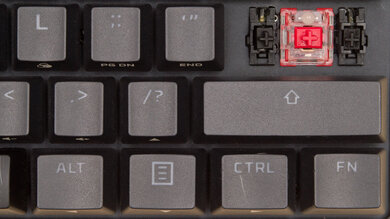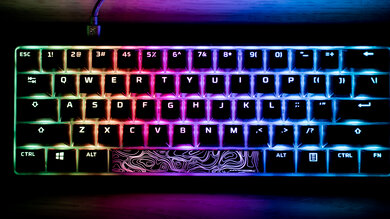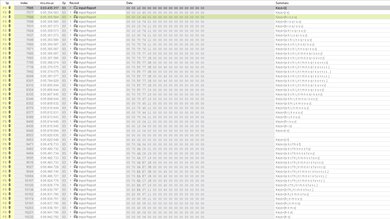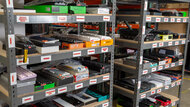The HyperX Alloy Origins 60 is a compact 60% mechanical gaming keyboard. Thanks to its aluminum body, it feels fantastically well-built. It uses HyperX Red linear switches which feel very light and responsive, and they require less force to actuate than other linear switches do. It has full RGB backlighting with an extremely customizable brightness level, letting you bring the minimum brightness to 1%, which isn't something we see on most keyboards. The click latency is incredibly low, so it should feel very responsive while gaming. You can set macros to any key you want using the NGENUITY software; however, its customization software is only available on Windows. Unfortunately, while it has two incline settings, it doesn't come with a wrist rest.
Our Verdict
The HyperX Alloy Origins 60 is fantastic for gaming. This very well-built keyboard uses HyperX Red linear switches, which feel very light and responsive. It has an incredibly low click latency, full RGB backlighting, and you can set macros to any key through the NGENUITY software. Unfortunately, while it has two incline settings, it doesn't come with a wrist rest.
-
Feel fantastically well-built.
-
Light and responsive linear switches.
-
Incredibly low click latency.
-
All keys are macro-programmable.
-
Customizable RGB backlighting.
-
Mediocre ergonomics.
-
Customization software only available on Windows.
The HyperX Alloy Origins 60 is good for office use. This very well-built keyboard uses HyperX Red linear switches that feel very light to type on and are quiet, so they shouldn't bother anyone around you in a quiet setting. Unfortunately, it isn't wireless so you can't pair it to multiple devices at once. Also, while it has two incline settings, it doesn't come with a wrist rest.
-
Feel fantastically well-built.
-
Quiet typing noise.
-
Light and responsive linear switches.
-
Customizable RGB backlighting.
-
Mediocre ergonomics.
-
Customization software only available on Windows.
The HyperX Alloy Origins 60 is a wired keyboard and isn't designed for use with a mobile device.
The HyperX Alloy Origins 60 is very good for programming. This very well-built keyboard uses HyperX Red linear switches that feel very light and shouldn't cause any fatigue; however, the compact size may cause you to make more typos and to type slower if you aren't used to the condensed layout. It has full, customizable RGB backlighting and macro-programmable keys. Unfortunately, it isn't wireless, so you can't pair it to multiple devices at once. Also, while it has two incline settings, it doesn't come with a wrist rest.
-
Feel fantastically well-built.
-
Light and responsive linear switches.
-
All keys are macro-programmable.
-
Customizable RGB backlighting.
-
Mediocre ergonomics.
-
Wired-only design.
-
Customization software only available on Windows.
The HyperX Alloy Origins 60 isn't ideal for home theater PC setups. It's a wired keyboard, which isn't ideal if you want to avoid running a cable across the living room. It also lacks a trackpad, so you need a mouse to navigate the user interface. Due to its compact size, it doesn't have any dedicated media keys.
-
Customizable RGB backlighting.
-
Wired-only design.
-
No trackpad or trackball.
-
Customization software only available on Windows.
-
Customization software only available on Windows.
- 8.3 Gaming
- 7.0 Office
- 2.6 Mobile/Tablet
- 7.7 Programming
- 2.9 Entertainment / HTPC
- 7.9 Raw Performance
Changelog
- Updated Nov 29, 2023: We've converted this review to Test Bench 1.3.1, which adds a new estimated PCB latency test to the Single-Key Latency section and a new Analog test to the Switches section of this review. You can see the full changelog here.
- Updated Oct 27, 2023: We've converted this review to Test Bench 1.3, which overhauls how key input is evaluated. We've added new tests for Single Key Latency, Multi Key Latency, Data Transmission, and Chord Split. We've also introduced a new Raw Performance usage and adjusted how the Gaming and Office usage scores are calculated. You can see the full changelog here.
- Updated Jun 15, 2023: We've converted this review to Test Bench 1.2. This update introduces new Backlight Features and Backlight Clarity test boxes. We've also added a new Switches test box, added additional test comparisons to our Hardware Customizability test box that we introduced with our last Test Bench. For an in-depth look at our changes, you can see our full changelog here.
- Updated May 19, 2023: We've converted this review to Test Bench 1.1. This update adds several new tests addressing Hardware Customization, Macro Keys And Programming, and Wireless Mobile Compatibility. We've also added new objective evaluations to the Typing Noise test, and we've simplified several tests and removed several others that were no longer relevant. For an in-depth look at all our changes, you can see our full changelog here.
- Updated Mar 30, 2021: Review published.
Check Price
Differences Between Sizes And Variants
The HyperX Alloy Origins 60 has a full-sized variant called the HyperX Alloy Origins and a TKL variant called the HyperX Alloy Origins Core, both of which offer similar features to the Origins 60 but have different layouts. You can see the label of our unit here.
Compared To Other Keyboards
The HyperX Alloy Origins 60 is an incredible gaming keyboard. It uses HyperX Red linear switches, which feel very light and responsive, but they require less force to actuate than other linear switches, like Cherry MX Red or Gateron Red. It has full RGB backlighting with individually-lit keys; however, it isn't good at color mixing, so setting the lighting to white may have hints of other colors in it.
For other options, check out our recommendations for the best gaming keyboards, the best mechanical keyboards, and the best keyboards.
The HyperX Alloy Origins 60 and the Razer Huntsman Mini are both compact 60% mechanical gaming keyboards. Both have full RGB with individually-lit keys and easy-to-use customization software that are both only available on Windows. Also, all keys on both boards are macro programmable. The Razer is available with Razer's clicky optical switches and linear optical switches, while the HyperX is only available with HyperX linear switches.
The HyperX Alloy Origins 60 and the HyperX Alloy Origins 65 are two very similar compact mechanical keyboards designed for gaming use, but with some minor differences. The Origins 65 has dedicated arrow keys and a few navigational cluster keys, which the Origins 60 lacks. The Origins 65 also has slightly better latency.
The HyperX Alloy Origins and the HyperX Alloy Origins 60 are very similar gaming keyboards, but they have different layouts. The Origins is a full-sized keyboard, while the Origins 60 has a compact 60% layout. Aside from that, the Origins 60 comes with PBT keycaps instead of ABS keycaps like the Origins, and you can set the RGB brightness to a much lower setting on the Origin 60 if you don't like the lighting being too bright. They use the same HyperX Red switches which feel very light and responsive, but the Origins 60's compact layout might cause you to type slower if you aren't used to the smaller size.
The HyperX Alloy Origins 60 and the SteelSeries Apex Pro Mini are both compact gaming keyboards, but the SteelSeries has a unique feature that allows you to adjust the pre-travel distance on a per-key basis. On the other hand, the HyperX has an excellent build quality, and it's more straightforward than the SteelSeries as it's an out-of-the-box unit with minimal customization options.
The HyperX Alloy Origins 60 and the Corsair K70 PRO MINI WIRELESS are compact gaming keyboards with incredible performance. The Corsair is a wireless unit with a hot-swappable circuit board so you can change out the stock Cherry MX switches easily while the HyperX is a wired-only unit that comes with a limited selection of switch types. While the Corsair keyboard offers much better latency, the HyperX has a much better build quality and a more wallet-friendly price point.
The HyperX Alloy Origins 60 is much better for gaming than the ROYAL KLUDGE RK61, but they're designed for different uses. The HyperX has much lower latency and has macro-programmable keys, which the ROYAL KLUDGE doesn't have, making it a better gaming keyboard. It also has RGB backlighting, but the ROYAL KLUDGE has an RGB variant too. The ROYAL KLUDGE is better for mobile use because it's wireless, meaning you can connect with up to three devices at once over Bluetooth, and it's lighter. The ROYAL KLUDGE is also available in different switch types, while the HyperX is just available with HyperX Red switches.
The HyperX Alloy Origins 60 and the HyperX Alloy FPS Pro are both mechanical gaming keyboards. The Origins 60 has RGB backlighting and much lower latency, and all of its keys are macro-programmable. Also, the Origins 60 has customization software. On the other hand, if you want a dedicated F-row, dedicated arrow keys, and you don't mind only having red backlighting, the FPS PRO could be a good choice. Also, the FPS PRO is available with Cherry MX Red linear switches and Cherry MX Blue clicky switches, while the Origins 60 is only available with HyperX Red linear switches.
The HyperX Alloy Origins 60 and the Corsair K65 RGB Mini are wired gaming keyboards with comparable performance and compact 60% form factors. The HyperX has multiple incline settings and comes with linear HyperX Red switches. Unfortunately, its companion software isn't compatible with macOS, and it isn't available in any other switch types. Also, the RGB lighting has poor color mixing as the white displays a noticeable bluish-purple tint. On the other hand, the Corsair has better latency, companion software compatible with Windows and macOS, and linear Cherry MX Speed switches.
The Redragon Dragonborn K630 RGB and the HyperX Alloy Origins 60 are both compact 60% mechanical boards, but the HyperX performs better overall. The HyperX keys are PBT and feel more stable, which gives it a much better typing quality. Also, it has much lower latency and media hotkeys by default. On the other hand, the Redragon is available with clicky, tactile, and linear switches, and the board is hot-swappable. Meanwhile, the HyperX is only available with linear switches.
The HyperX Alloy Origins 60 and the Ducky One 2 Mini V2 are both 60% compact mechanical keyboards, but the HyperX is better for gaming thanks to its significantly lower latency. Also, it has easy-to-use customization software to set macros and change the RGB backlighting. However, the HyperX isn't as good as the Ducky at color mixing. If you don't like the feel of linear switches, the Ducky is a better choice since it's available in a variety of Cherry MX, Gateron, and Kailh switches.
The HyperX Alloy Origins 60 and the Obinslab Anne Pro 2 are both compact 60% mechanical gaming keyboards, but the Obinslab is better overall. If you prefer a wireless keyboard, the Obinslab is a good choice since it can pair with up to four devices at once over Bluetooth, including mobile devices. Also, the Obinslab has one of the lowest click latencies we've tested, and it's available in a variety of different switch types. However, if you prefer a wired option, the HyperX is still a fantastic choice, but it only comes with proprietary linear switches.
The HyperX Alloy Origins 60 is better for gaming than the Ducky One 2 SF. The HyperX has a much lower click latency, and it comes with customization software to change backlighting effects, remap keys, and set macros. The Ducky can have macros set to any key, but all customizations must be done directly from the board. The HyperX is available with HyperX Red linear switches which feel light and very responsive. However, if you prefer a different feel, the Ducky is available in a variety of Kailh and Cherry MX switches.
The HyperX Alloy Origins 60 and the Razer Huntsman Tournament Edition are both mechanical gaming keyboards, but the HyperX is a compact 60% size and the Razer is a TenKeyLess size. If having a dedicated F-row and dedicated arrow keys is important to you, the Razer is a better choice since the HyperX lacks both. Also, the Razer has a lower latency, and it's better at color mixing. Both boards are only available with proprietary linear switches, but the Razer uses Razer Linear Optical switches and the HyperX uses HyperX Red switches.
The Fnatic miniSTREAK and the HyperX Alloy Origins 60 are both wired mechanical gaming keyboards, but the Fnatic is a TenKeyLess, and the HyperX is a compact 60%. The Fnatic's larger size gives it room for a dedicated function row and dedicated arrow keys instead of secondary functions like the HyperX. The HyperX is only available with HyperX Red switches, and the Fnatic is available with Cherry MX Silent Red or Kailh Speed Silver switches. If having the lowest possible latency matters a lot to you, the HyperX is a superb option to consider since its latency is much lower than the Fnatic's, though the Fnatic should still feel responsive.
The HyperX Alloy Origins 60 and the Razer BlackWidow V3 Mini HyperSpeed are fantastic compact gaming keyboards, but the Razer is better overall. It has much lower latency, bright RGB backlighting with good color mixing, and you can use it wired and wirelessly. You can pair it with up to three devices at once via Bluetooth. It's available with linear Razer Yellow and clicky Razer Green switches, but unfortunately, we had a quality control issue with our Razer Green switches, which resulted in a different audible and tactile feedback in some switches. If you prefer a wired-only keyboard and don't need dedicated navigation keys, the HyperX is a fantastic choice. It comes with PBT keycaps, but it's only available with linear HyperX Red switches.
The HyperX Alloy Origins 60 and the Razer Huntsman Mini Analog are both wired, compact mechanical keyboards designed for gaming use, but the Razer performs slightly better overall. The Razer has lower latency and a feature that allows you to adjust the pre-travel distance on a per-key basis. You can also program macros directly on the keyboard without using the software. On the other hand, the HyperX feels better-built thanks to its all-aluminum case.
Test Results
If you want a similarly performing compact board with dedicated arrow keys, check out the HyperX Alloy Origins 65.
The HyperX Alloy Origins 60 feels incredibly well-built. Its aluminum chassis and base plate feel sturdy and have no flex to them. The base plate has a smooth, matte black finish, and the PBT doubleshot keycaps don't accumulate oils or fingerprints. The secondary functions are printed onto the front-facing side of the keys, so they're easy to see when using the keyboard; however, light doesn't shine through them. Unfortunately, the keys don't feel very stable since there's some wobble to them. While it isn't unreasonable, it is noticeable. It comes with an additional spacebar and HyperX keycap, but note that they're made of ABS plastic and not PBT like the other keycaps already on the board.
The ergonomics are mediocre. It has two incline settings, with a very steep maximum setting that may cause some wrist strain. The four rubber feet and the rubber pads on each kickstand feel sturdy and shouldn't collapse if you push the keyboard forwards. Note that while the HyperX website advertises the two inclines at 7 degrees and 11 degrees, we measured 9 degrees and 14.5 degrees, respectively.
The HyperX Alloy Origins 60 has full RGB backlighting with individually-lit keys that can be customized via HyperX's NGENUITY software. You can change the brightness level on the board itself, but the software lets you set the brightness even lower to 1%.
The HyperX Alloy Origins 60's USB-C to USB-A cable is detachable, making it easy to replace if it gets damaged or if you want to replace it with a different one.
It's a wired board that can't be used wirelessly. If you'd like a wireless option with dedicated arrow keys, check out the ASUS ROG Falchion.
You can set macros to any key on the HyperX Alloy Origins 60 and change the backlighting effects using the NGENUITY software. Secondary functions, including the media keys, can be accessed through hotkeys.
The HyperX Alloy Origins 60 has very good typing quality. The PBT keycaps feel nice, but the keys wobble noticeably while typing. The HyperX Red linear switches feel very light and responsive, but since they require slightly less force to actuate than other linear switches, you may find yourself typing slower than usual to correct accidentally-hit keys. If you aren't used to typing on a compact keyboard, you might need to focus more than usual on making sure you're hitting the correct keys.
Typing on this keyboard is quiet and shouldn't bother those around you, even in a noise-sensitive environment.
The HyperX Alloy Origins 60 uses proprietary linear switches which require less force to actuate than other linear switches. They feel very responsive and very light to type on. Since they're linear switches, they don't provide any tactile feedback. If you prefer a different switch feel, the Ducky One 2 Mini V2 is also a 60% compact keyboard that is available in a very wide variety of switch types.
The latency is incredibly low, which should provide a very responsive gaming experience.
The HyperX Alloy Origins 60 is compatible with HyperX's NGENUITY software, which lets you customize the backlighting, the hotkeys, and set macros to any key you want. However, it can only be downloaded from the Microsoft Windows Store, so macOS or Linux users can't install it. The Cloud Sync feature relies on your Microsoft account to save your settings, so any computer with NGENUITY that's signed in to your account will have your customizations.
Since the NGENUITY software is only available on Windows, Linux and macOS users can't customize the keyboard. Like most keyboards, the Print Screen button doesn't work on macOS. However, all the keys function properly on Linux.
Comments
HyperX Alloy Origins 60: Main Discussion
Let us know why you want us to review the product here, or encourage others to vote for this product.
Update: Compared their in-ear stability with the Jabra Elite 8 Active True Wireless’.



































